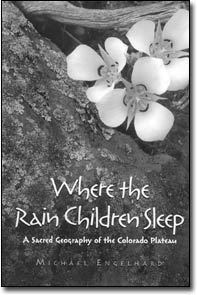|
by Amy Maestas
 Where
the Rain Children Sleep: A Sacred Geography of the
Colorado Plateau, by Michael Engelhard Where
the Rain Children Sleep: A Sacred Geography of the
Colorado Plateau, by Michael Engelhard
The Lyons Press. 206 pages
I n the interest of giving writer Michael Engelhard
his literary due, this review won't categorize his new
book as nature writing. The flooded genre tends to bury
the authors who truly write about relating to nature
instead of being obligatory environmental indoctrinators.
So, if you will, Engelhardrecently released collection
of essays, Where the Rain Children Sleep: A Sacred
Geography of the Colorado Plateau , is instead a
series of prosaic vignettes of practical knowledge and
experience with the Colorado Plateau as the backdrop.
In this book, Engelhard, a self-proclaimed "sagebrush
scholar," provides readers 14 essays that are authentic
and elegantly written. His prose is quiet and respectful.
His thoughts and philosophies - of which there are many - are
not drenched in naive political extremism, but are instead
humble and relevant. In an essay explaining how the rumbling
noises from off-road vehicles destroys the hearing of
small animals in the desert, Engelhard, a conservationist,
educates instead of launching into a finger-wagging screed.
As he travels various places throughout the vast Colorado
Plateau, Engelhard creates a sense of place for readers
with an amalgam of history and science. He isn't making
brilliant discoveries. Rather, he's experiencing the
awe and wonder of a region that is geologically and topographically
so distinct from other parts of the West. He takes readers
to sacred American Indian places, the Maze in Canyonlands
National Park, down the Green River (wondering, on this
trip, if he'd rather be floating with John Wesley Powell
or Edward Abbey) and so many more places. All the while,
he provokes thought while seeking his self.
Often, Engelhard writes about - or at least guesses
about - the origin of place names. He has made a wry
observation about how so many of the places have monikers
related to hell and the devil. To wit: Devil's Slide,
Hell's Kitchen and Satan's Gut. Yet, just as he ponders
this, he stumbles in his next voyage upon someplace labeled
saintly and angelic. He writes most about this in "Beelzebub's
Weekend Retreat," where he eventually realizes that the
desert, in spite of the names, is neither "evil nor benign."
More importantly, Engelhard's essays adequately convey
the weight of silence and the need for gaining a perspective
on life by getting lost. At times, he seems a mellower
version of the itinerant Everett Ruess (who mysteriously
disappeared in Utah's wilderness in the early 1930s).
Practicing what he preaches, Engelhard writes: "The way
to intimacy of perception is to toss your car keys. Lace
up your boots and regain a pedestrian purity. Reclaim
the openness of a toddler's first encounter with the
world! It works equally well for touch, smell and hearing,
and each newly awakened sense will sharpen your awareness
exponentially. The Japanese call this 'seeing with the
eyes of the heart.'"
Indeed, the author relies on his heart to connect with
the natural world. Along the way, he presents the hope
inherent in the world in words.
|